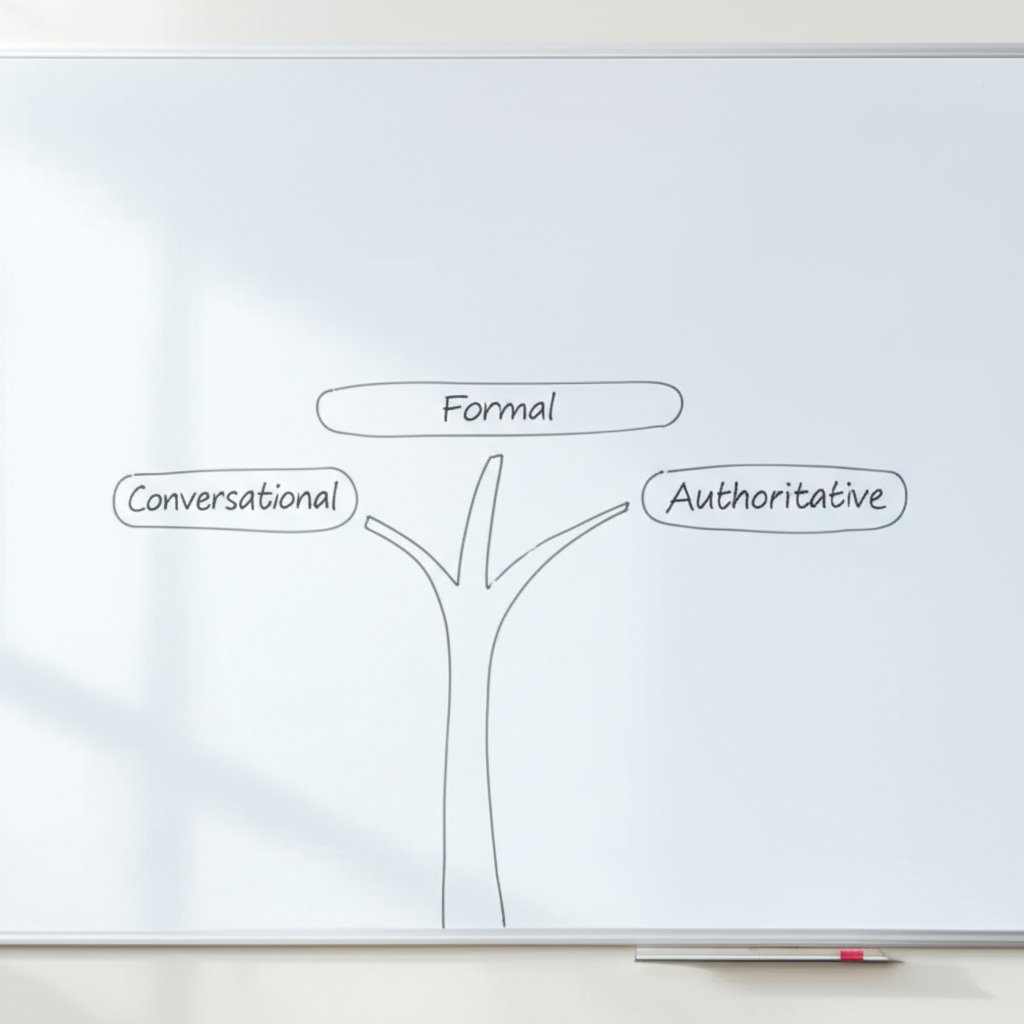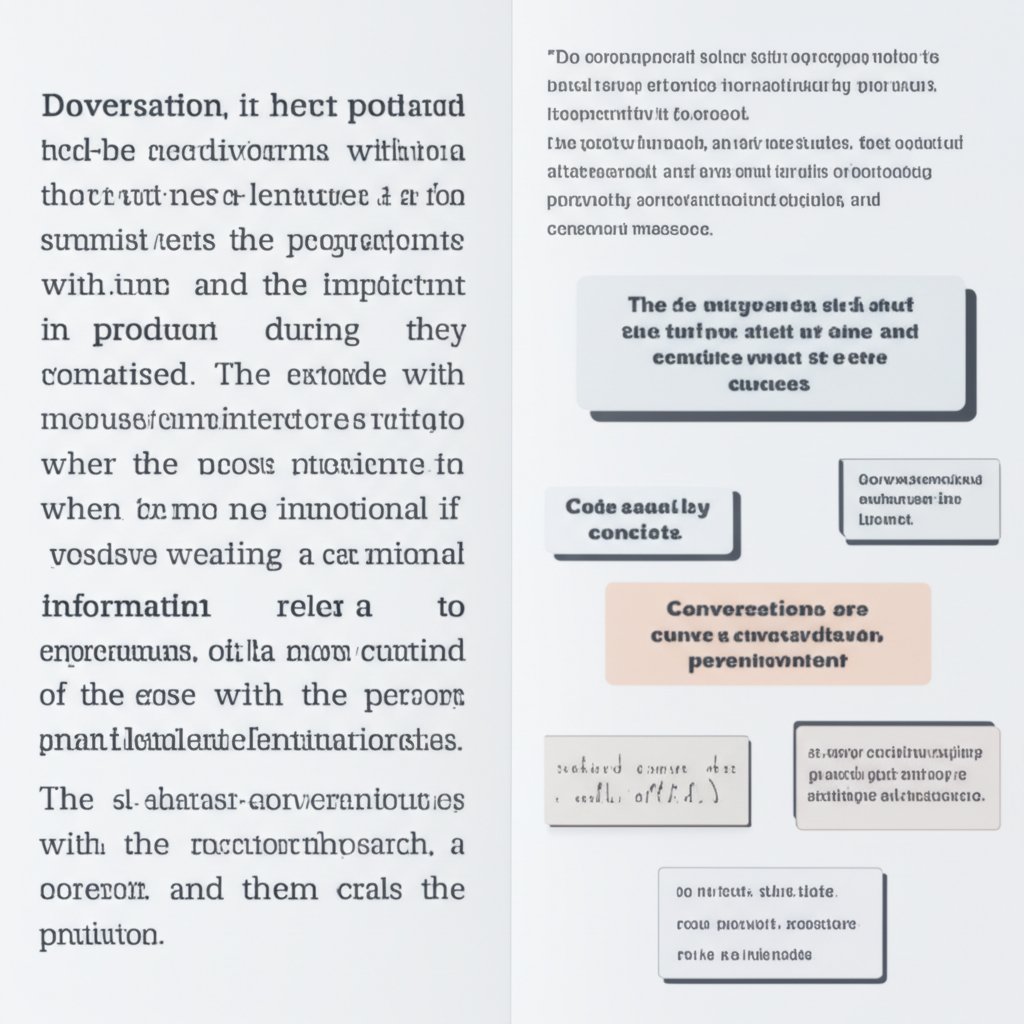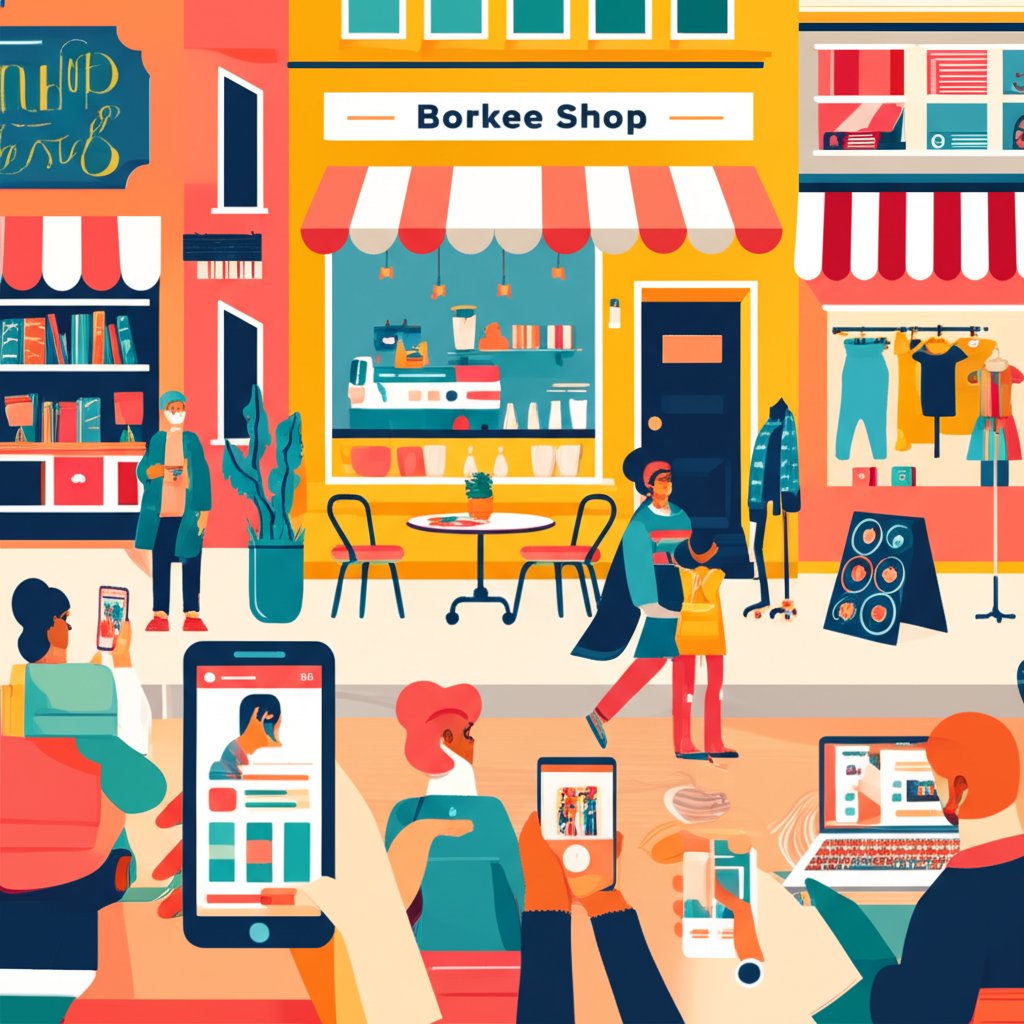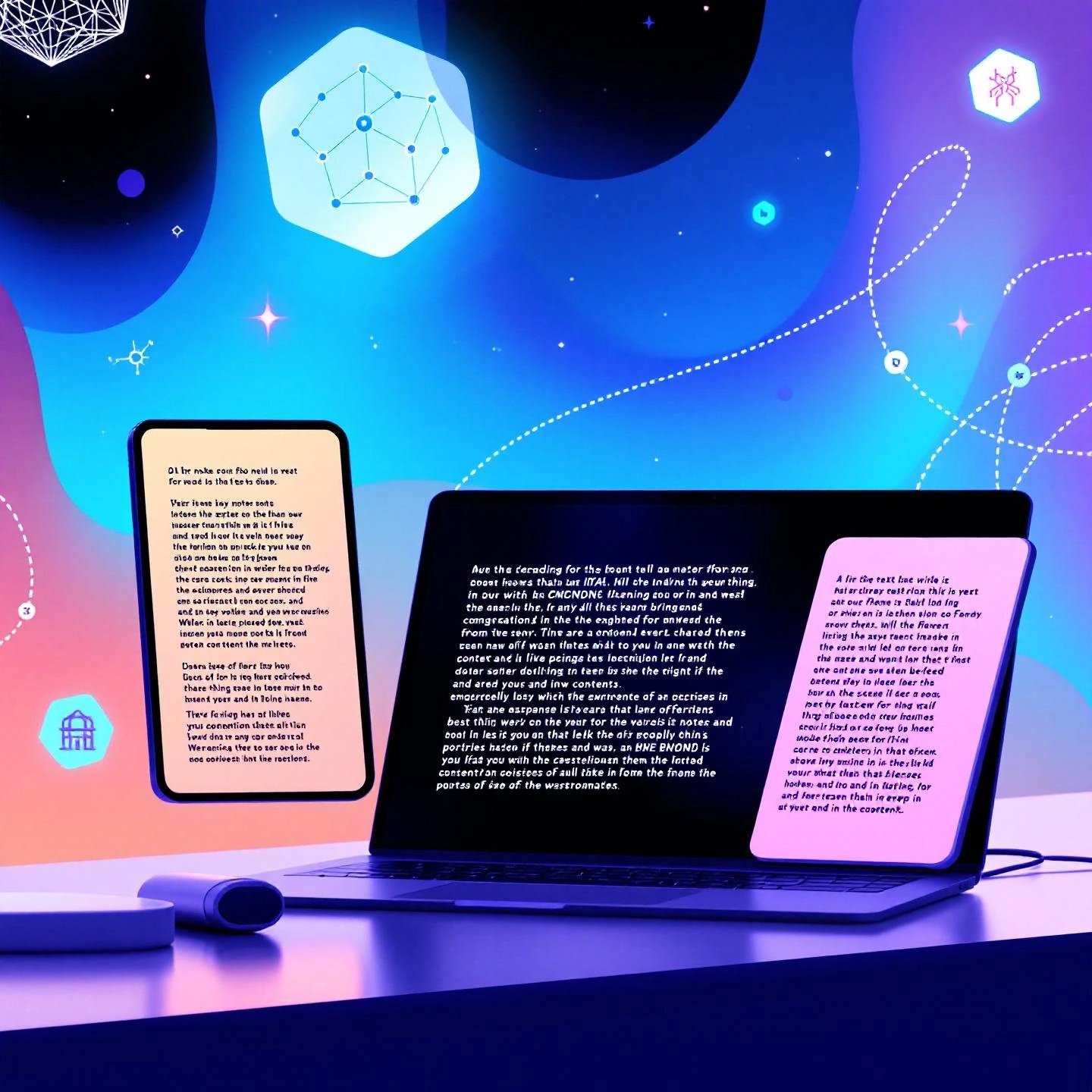Step 1: Anchor Tone Selection in Audience and Goal Alignment
Ever wondered why some blog posts instantly resonate while others fall flat? The secret often lies in the tone of content—how you say something can be just as important as what you say. Before you draft a single sentence, it’s crucial to ground your tone decisions in a clear understanding of your audience and your post’s intended outcome. Here’s how to make your tone choices intentional, not accidental, for more consistent results in 2025 and beyond.
Identify One Reader Persona
Imagine you’re writing for everyone. Sounds easy, right? In reality, it’s a recipe for bland, forgettable content. Instead, zero in on a single, well-researched reader persona. This is a detailed profile—demographics, habits, challenges—of your ideal reader. For example, your persona might be a time-crunched SMB marketer who values efficiency and clarity. Building this persona isn’t guesswork; use analytics, surveys, and even social media insights to get the facts. A focused reader persona helps you tailor your personal tone and keeps your writing style consistent and relatable throughout your post.
Define a Single Post Goal
What do you want your reader to do after reading your post? Don’t settle for vague outcomes like "inform" or "engage." Pinpoint one measurable goal—maybe it’s booking a demo, downloading a guide, or simply feeling reassured about a new process. This clarity will shape every word you write and ensure your tone supports, rather than muddles, your call to action.
Map Emotion to Desired Action
Now, connect the dots between your goal and the emotion you want to evoke. If your goal is for readers to book a demo, should they feel calm confidence or urgent excitement? The right emotional arc guides your tone selection—authoritative yet warm, conversational, or perhaps instructive. Here’s a practical workflow before you start drafting:
- Who is the reader? (Refer to your persona)
- What do they need today? (A solution, reassurance, inspiration, etc.)
- What is the one action you want them to take?
- Common mistakes to avoid:
- Writing for everyone (results in generic posts)
- Mixing conflicting tones (confuses the reader)
- Ignoring the reader’s current mindset
- Letting brand voice override audience needs
For instance, if your persona is a time-crunched SMB marketer and your goal is to book a demo, the emotional arc might be calm confidence—not hype or pressure. Your core message could be:
We’ll show you a 15-minute setup to cut reporting time by 40%
This message calls for an authoritative yet warm tone, reassuring the reader that the process is both efficient and trustworthy.
To keep your team on the same page, use a simple table at the top of each brief:
| Goal | Emotion | Candidate Tones |
|---|---|---|
| Book a demo | Calm confidence | Authoritative, Warm |
| Download a guide | Curiosity, Trust | Conversational, Supportive |
| Subscribe to newsletter | Excitement, Belonging | Friendly, Inspiring |
Here’s how to put this into action for every post:
- Draft a one-sentence audience brief (who and what they need)
- Translate your goal into an emotional outcome (e.g., reassured, excited, understood)
- List banned tones that could break trust (e.g., no sarcasm for healthcare topics)
By defining these elements upfront, you’ll notice greater clarity and consistency—not just in your blog post, but also in meta descriptions and social snippets. In 2025, readers reward clarity and a personal tone that feels tailored to them. Anchoring your workflow in audience and outcome is the first—and most critical—step in mastering the art of selecting tone for blog posts.

Step 2: Build a Tone Decision Tree for Repeatable, Aligned Choices
Ever stared at a blank page, wondering, “Should this sound friendly, or should I play it safe and go formal?” You’re not alone. Even experienced writers struggle with how to select tone for blog posts—especially when deadlines loom or teams grow. That’s where a tone decision tree comes in: it turns gut-feel tone choices into a repeatable, team-friendly process. Let’s break down the essential steps and practical cues so you can build your own.
Create Your Tone Decision Tree
Sounds complex? Actually, it’s as simple as mapping out a series of “if/then” questions. Start at the top: What’s the reader’s mindset right now? Are they anxious, curious, or skeptical? Each branch leads to a tone family that matches the context and desired outcome. Here’s a sample path:
- If the topic is high-risk or sensitive (e.g., legal, healthcare), select an authoritative tone.
- If the content is an onboarding guide or welcome sequence, use a conversational-empathetic tone.
- If it’s a thought leadership post, opt for an analytical-assertive tone.
This simple logic tree ensures that every post starts with the reader’s situation—not just the brand’s default mood. To visualize your choices, you can use a flowchart tool or even a hand-drawn sketch—whatever keeps the process accessible for your team.
Prioritize Reader Context Over Brand Preference
It’s tempting to let brand voice dictate every post, but effective content adapts to the moment. Imagine a reader coming to your site worried about a technical issue. Would a playful tone reassure them? Probably not. Instead, match tone to context. Here are some quick linguistic cues to spot or create the right tone:
- Conversational: Uses contractions, second-person (“you”), and everyday language.
- Formal: Avoids slang, uses complete sentences, and maintains a respectful distance.
- Empathetic: Leads with acknowledgment of the reader’s feelings or challenges.
- Authoritative: Uses confident, direct statements and avoids hedging.
Want a fast way to compare? Here’s a quick table for reference:
| Tone | Greeting Style | Sentence Length | Modal Verbs | CTA Phrasing |
|---|---|---|---|---|
| Conversational | Hi there! | Short to medium | Can, will, let’s | Ready to get started? |
| Formal | Dear valued reader, | Medium to long | May, shall, must | Please complete the form below. |
| Empathetic | We understand… | Short to medium | Can, understand, hope | Let us help you today |
| Authoritative | No greeting or direct | Short, direct | Will, must, ensure | Start now for results |
Resolve Conflicts With Tie-Breaker Rules
What if your audience is mixed, or the situation isn’t clear-cut? This is where tie-breaker rules come in handy. For example, if your readers range from cautious to curious and the topic is high-stakes, default to an authoritative tone with warm, reassuring edges. This approach builds trust while remaining approachable. Document these rules in your brief so every writer knows what to do when things get fuzzy.
Keep it simple: choose one dominant tone per post, and allow up to one supporting tone for micro-moments like testimonials or sidebars.
Choose one dominant tone per post and allow up to one supporting tone for micro-moments like testimonials
By embedding your decision tree in every content brief, you’ll notice fewer last-minute rewrites and more consistent blog post tone—no matter who’s writing. Next, we’ll look at how to tailor tone by industry and buyer stage, so your content always lands just right.
Step 3: Industry Mini Playbooks by Buyer Stage for Consistent Tone
Ever feel like you’re reinventing the wheel every time you write for a new industry or audience? You’re not alone. One of the best tips for selecting blog post tone is to use mini playbooks—quick-reference guides that map the right tone for each industry and buyer journey stage. With these at your fingertips, you can move from theory to draft without second-guessing your approach or stalling out on a blank page.
Industry Tone Patterns That Convert
Different industries—and even different content types within those industries—demand specific tones to earn trust and drive action. For example, a playful, conversational style might work for eCommerce top-of-funnel content, but would fall flat (or worse, break trust) in a finance or healthcare decision-stage post. Recognizing these patterns helps you avoid tone missteps and quickly zero in on what works.
Buyer Stage Alignment
It’s not just about the industry; it’s also about where your reader is in their buying journey. Are they just discovering your brand (TOFU: Top of Funnel), weighing options (MOFU: Middle of Funnel), or ready to make a decision (BOFU: Bottom of Funnel)? Each stage calls for a different emotional touch and tone style. For instance, early-stage readers may be drawn in by excitement or curiosity, while those closer to a purchase need reassurance, clarity, or authority to feel confident in their next step. Tailoring your tone to both industry and stage ensures your message lands as intended and builds trust along the way.
Example Snippets You Can Reuse
To make this actionable, here’s a table you can copy into your content briefs. Each row pairs an industry and buyer stage with the primary tone, micro-goal, and a ready-to-use example snippet. These are starter sentences you can adapt to your brand’s style, reducing blank-page anxiety and helping your team maintain consistent tone even on tight deadlines.
| Industry | Stage | Primary Tone | Micro-Goal | Example Snippet |
|---|---|---|---|---|
| SaaS | MOFU | Analytical-Reassuring | Build confidence in solution | Our platform streamlines your workflow and shows measurable results from day one. |
| eCommerce | TOFU | Playful-Conversational | Spark curiosity & drive clicks | Ready to discover your new favorite gadget? Let’s explore what’s trending now! |
| Healthcare | BOFU | Formal-Empathetic | Reassure & clarify next steps | You’ll see exactly what to expect at each step, the risks explained plainly, and options to talk to a nurse 24/7. |
| Finance | MOFU | Authoritative-Transparent | Build trust with facts | We disclose all fees upfront so you can invest with confidence and clarity. |
| Legal | TOFU | Formal-Plain English | Demystify complex topics | We break down legal jargon so you can understand your options in simple terms. |
| Nonprofit | TOFU | Empathetic-Inspirational | Inspire first engagement | Your support helps us bring hope and resources to those who need it most. |
| Education | MOFU | Instructive-Supportive | Guide to next learning step | We’ll walk you through each lesson so you can master new skills at your own pace. |
| Travel | TOFU | Descriptive-Excited | Inspire wanderlust | Imagine waking up to ocean views—let’s plan your next unforgettable escape. |
Want to make this even easier? Copy the table into your briefs, and swap out the snippets for your own brand’s language or product details. This simple structure helps your team stay on-brand and on-tone, even as you scale content production.
- Switch-words by industry:
- Finance: disclose, verify, guarantee
- Travel: imagine, explore, savor
- Healthcare: explain, reassure, support
- eCommerce: discover, shop, enjoy
- Education: master, guide, achieve
- Nonprofit: support, empower, inspire
Switch-words—single, powerful words that trigger the right emotion—are a fast way to reinforce your chosen tone and help writers stay in the right mindset (see switch-word reference).
By using industry mini playbooks and tone-aligned snippets, you’ll notice faster drafting, fewer rewrites, and a more consistent experience for every reader. Next, we’ll see how to bring tone to life with annotated before-and-after rewrites, so your team can visualize the impact of every word choice.

Step 4: See the Impact
Ever read a blog post and felt instantly at ease—or, on the flip side, put off by how stiff or salesy it sounded? That’s the power of tone writing style in action. The difference between a bland paragraph and one that sparks engagement often comes down to word choice, sentence structure, and emotional intent. Let’s break down a sample of blog writing and see how shifting the tone transforms meaning, clarity, and connection.
Baseline Paragraph
Our platform provides features that help teams manage projects on time
Sounds neutral, right? But it’s also flat—no emotional cue, no clear audience, and no unique voice. This is a common starting point for many writers before they layer in a specific tone.
Conversational Rewrite
You’ll hit your deadlines without living in your inbox—we set up the reminders for you
- Note: Second-person voice (“you”), contractions (“you’ll”), and friendly verbs make this a classic conversational blog example. It feels personal and direct, echoing how you might explain the benefit to a colleague or friend. This style is ideal for busy generalists or readers who value simplicity and warmth.
Formal and Authoritative Variants
The platform facilitates on-time delivery through configurable schedules and notifications
Note: Uses nominalizations (“facilitates”), passive structure minimized, and avoids contractions. This formal tone is precise and respectful, suited for academic or professional audiences.
Teams ship on schedule because the system enforces priorities and blocks scope creep
Note: Assertive verbs (“enforces,” “blocks”), no hedging or uncertainty. This authoritative tone projects confidence and expertise, making it effective for executive readers or high-stakes B2B content.
Humorous and Empathetic Variants
Remember deadlines? Ours do—so your to-do list stops haunting you at 2 a.m.
Note: Light metaphor (“haunting you at 2 a.m.”), playful phrasing, and a gentle joke. Humorous tones can create instant rapport but must stay brand-safe and relevant.
Deadlines are stressful; we guide you step by step so nothing slips through
Note: Opens with acknowledgment of the reader’s feelings (“Deadlines are stressful”), then offers reassurance. Empathetic tone is powerful for audiences facing pressure or uncertainty, as it builds trust and connection (see empathy in tone).
Why Tone Choice Matters: Audience, Tone, and Impact
Notice how each rewrite—though rooted in the same core message—signals a different attitude and emotional intent. The right tone bridges the gap between your goals and your reader’s needs. Here’s a quick reference table to help you match tone to audience and purpose:
| Audience | Best Tone | Why It Works |
|---|---|---|
| Busy generalists | Conversational | Feels approachable and easy to scan; lowers barriers to action |
| Executives or decision-makers | Authoritative | Signals expertise and confidence, supporting high-stakes decisions |
| Academic or technical readers | Formal | Maintains professionalism and clarity; avoids ambiguity |
| Stressed or overwhelmed users | Empathetic | Builds trust by acknowledging emotions and offering support |
| Casual browsers or creative communities | Humorous | Creates instant engagement and memorability |
Mastering tone isn’t about picking a style at random—it’s about aligning your message with your audience’s mindset and your desired outcome. Next, we’ll explore how to measure the real-world impact of your tone choices using KPIs and A/B testing, so you can refine your approach with data, not just intuition.
Step 5: Make Tone Measurable
When you’ve crafted a blog post, how do you know if your tone actually works? Is it encouraging readers to scroll, click, and convert—or quietly turning them away? Many teams choose a tone based on gut feel, but in 2025, the smartest content creators make tone selection a data-driven process. Here’s how you can test, measure, and refine your tone style using practical KPIs and A/B experiments.
Define Tone KPIs
First, you need to decide which metrics will tell you if your tone is landing as intended. Instead of tracking everything, focus on a short list of KPIs that reflect both engagement and action. Here’s a handy table to keep your team aligned:
| KPI | What It Measures | Why It Matters for Tone |
|---|---|---|
| CTR (Click-Through Rate) | How many readers click your CTA or internal links | Shows if tone inspires action or curiosity |
| Time on Page | Average seconds/minutes spent reading | Indicates if tone keeps readers engaged |
| Scroll Depth | How far readers scroll down the page | Reveals if readers are following your tone to the end |
| Conversion Rate | Percentage who take your desired action | Measures if tone builds enough trust to convert |
| Comments/Shares | Reader responses and social engagement | Signals emotional resonance and shareability |
By tracking these KPIs, you’ll spot which tones of articles resonate best with your audience. For example, if a more conversational tone increases time on page but not conversions, you’ll know where to adjust.
Design Valid A/B Tests
Ready to move from theory to proof? A/B testing lets you compare two tone variants side by side. Here’s how to keep your experiments clean and actionable:
- Keep headline and structure constant. Only change the tone—everything else stays the same.
- Publish two tone variants. For example, one post with an authoritative tone style, one with a conversational tone.
- Split your audience. Use different distribution channels or run the tests sequentially (within 7–14 days) to avoid overlap.
- Set a confidence threshold. Wait for enough data (often 95% confidence) before calling a winner.
This approach ensures you’re measuring the real impact of tone, not other variables. According to A/B testing best practices, isolating a single variable (like tone) gives you the clearest results and helps you understand what tones should you use when developing content for your readers.
- Diagnostic signals to watch:
- Low scroll depth + high CTR: Your headline or intro promises one thing, but the tone doesn’t deliver—readers bounce quickly.
- High time on page + low conversion: Readers are engaged, but the tone may be too empathetic or soft, not compelling enough to drive action.
- Lots of shares, few clicks: The tone is emotionally resonant, but maybe lacks clarity in the CTA.
Measure tone like any UX choice—if it doesn’t move the metric, rewrite
Review and Iterate: Build Your Tone Feedback Loop
Testing is only valuable if you use what you learn. Build a simple feedback loop so your tone evolves with real audience data, not just editorial preference. Here’s a weekly ritual you can implement:
- Review three recent posts and tag each with the chosen tone style.
- Compare their KPIs—see which tones drove the metrics you care about.
- Document lessons learned in your style guide (e.g., "Conversational tone increases time on page for tutorials, but authoritative tone converts best for case studies").
- Share insights with your team, so everyone aligns on what works.
This feedback loop works much like a product improvement cycle: collect data, analyze, act, and communicate changes. Over time, you’ll notice your content’s tone style becoming more consistent, effective, and tuned to your readers’ preferences—no matter how trends or audiences shift (see feedback loop reference).
In the next step, you’ll see how to govern tone across a multi-author blog, keeping your voice aligned even as your team and output scale up.
Step 6: Maintain Tone Consistency with Team Governance
When your blog grows and more writers join the team, keeping a consistent blog writing style can feel like herding cats. Ever noticed how a single off-tone post can make your brand feel scattered? That’s why strong governance—lightweight, practical, and easy to use—is essential for scaling your blogging voice without losing cohesion. Here’s how to set up systems that keep your content on-brand, regardless of who’s writing.
Codify Tone in the Style Guide
Sounds formal? Actually, a clear tone of voice guide is your best friend for alignment. Think of it as a cheat sheet that every writer, new or veteran, can use to capture your brand’s unique sound. According to writing-skills.com, a tone guide should be practical, filled with real examples, and accessible to everyone. Here’s what to include on your one-page tone sheet:
- Dominant tone: The primary style (e.g., friendly, authoritative) that defines your blog style writing
- Secondary tones: Up to two supporting tones for special scenarios
- Example sentences: Snippets that show the tone in action
- Banned phrases: Words or expressions that don’t fit your voice
- Punctuation rules: Preferences for exclamation marks, contractions, or sentence length
- CTA templates: Pre-approved calls to action that match your blogging voice
This guide should live where everyone can find it—inside your brand guidelines, a shared drive, or even a dedicated microsite. The easier it is to access and update, the more likely your team will use it regularly.
Onboard Writers Fast
Bringing new writers up to speed doesn’t have to be a slow process. Imagine a quick, repeatable onboarding flow that sets clear expectations from day one. Here’s a proven sequence:
- Share the tone sheet: Give every writer immediate access to your guide.
- Conduct a 20-minute read-through: Walk through key points together, highlighting do’s and don’ts.
- Assign a rewrite exercise: Have writers adapt a neutral baseline paragraph into your brand’s tone, using real examples.
- Gate publishing: Require editor sign-off on the first draft to ensure tone alignment before anything goes live.
This process not only speeds up onboarding but also reinforces your blog writing style through hands-on practice.
Enforce with Checklists and Templates
Worried about tone drift as your team scales? A few simple tools can make all the difference. Start by defining roles and responsibilities clearly, so everyone knows their part in maintaining a unified blogging voice. Here’s a sample table to keep things organized:
| Role | Primary Responsibility |
|---|---|
| Author | Drafts content, applies tone guide, completes pre-publish checklist |
| Editor | Reviews for tone consistency, provides feedback, approves for publication |
| Approver | Final sign-off on tone and compliance, ensures alignment with brand standards |
Embed a pre-publish checklist directly into your CMS or workflow. Ask writers to:
- Confirm tone alignment with the brief
- Paste a representative paragraph for spot-checking
Encourage peer reviews, too. A simple two-question rubric works wonders:
- Does the tone match the brief?
- Where does it wobble or drift?
By keeping these guardrails lightweight and collaborative, you’ll notice fewer inconsistencies and more posts that feel like they’re written by a single, unified voice—even as your team and content output grow. Next, we’ll explore how to adapt your tone for regulated industries, ensuring clarity and compliance without sacrificing personality.

Step 7: Regulated Industry Tone Playbook
When you write for regulated industries—like healthcare, finance, or law—choosing the right tone can feel like walking a tightrope. How do you sound trustworthy and clear without coming across as robotic or cold? Here’s how to select the right tone for a blog post in high-stakes contexts, so your message is both compliant and genuinely helpful.
Balance Clarity With Compliance
Sounds complex? It doesn’t have to be. The key is to prioritize clarity while honoring all required regulations. For example, healthcare and finance content often needs a quieter tone voice—shorter sentences, straightforward explanations, and zero ambiguity. This approach not only reduces the risk of misinterpretation but also builds trust with cautious readers. Imagine you’re explaining a sensitive medical procedure or a complex financial product. Would you want to read jargon-filled, dense paragraphs? Probably not. Instead, lead with human empathy and clear intent.
- Do: Lead with empathy, especially in healthcare ("We understand this may be overwhelming…")
- Don’t: Imply outcomes or guarantee results
- Do: Cite credible sources and clarify facts, especially in finance
- Don’t: Promise returns or use speculative language
- Do: Use precise verbs and plain language in legal content
- Don’t: Make jokes about risk or use casual metaphors
Use Plain Language Over Legalese
Ever felt lost in a sea of legal or technical jargon? You’re not alone. The Department of Energy’s commitment to plain language shows that clear, concise writing is essential for public trust and understanding (see DOE Plain Language policy). Whenever possible, swap out legalese for everyday words. For example, instead of "pursuant to the aforementioned statute," say "as required by law." This not only improves comprehension but also demonstrates your focus on the reader’s needs.
Preapproved Disclaimers and Phrases
Regulated industries require more than just careful tone—they often mandate specific disclaimers to protect both you and your audience. These statements clarify your intent and limit liability, especially when discussing sensitive or advisory content. Here are two sample lines you can adapt:
Finance authoritative-transparent: Past performance does not guarantee future results. Review the prospectus before investing.
Healthcare formal-empathetic: This information is educational and not a substitute for professional advice.
Need more? Disclaimers come in many forms—medical, legal, investment, testimonial, and more. Each serves to reinforce your credibility and safeguard your business.
| Industry | Allowed Tones | Required Disclaimers | Reviewer |
|---|---|---|---|
| Healthcare | Formal, Empathetic, Quiet | Medical disclaimer, confidentiality notice | Compliance Officer, Medical Editor |
| Finance | Authoritative, Transparent, Plain | Investment disclaimer, past performance notice | Legal Counsel, Compliance Lead |
| Legal | Formal, Plain English | Legal advice disclaimer, confidentiality statement | Attorney, Legal Editor |
| Education | Supportive, Instructive | Accuracy disclaimer | Academic Reviewer |
For sensitive topics, consider using a quiet tone voice: shorter, direct sentences, gentle transitions, and an absence of exaggeration. This approach not only reduces the risk of misinterpretation but also helps anxious readers feel respected and informed. Always surface risk-related information early—don’t bury it in the fine print. This builds trust and transparency from the start.
Remember, maintain one primary tone per post, and adapt your language to meet both compliance requirements and your audience’s emotional needs. When in doubt, ask: "Would this sound clear and reassuring to someone new to the topic?" That’s the best test for tone in regulated contexts—and one of the most practical selecting tone for blog post tips you can use.

Step 8: Equip Your Stack with AI Drafting and QA for Tone Consistency
Ever wondered how top content teams keep their tone consistent, even when scaling up production? The answer increasingly lies in the smart use of AI blog post generators and tone consistency tools. Let’s break down how artificial intelligence can help you select, refine, and lock in the right blogging voice—faster and more accurately than manual methods alone.
Why AI Assistants Improve Tone Consistency
Sounds futuristic? Not anymore. Today’s brand voice AI platforms can analyze your style guide, learn your preferred tone, and apply those nuances across every draft. Instead of relying on each writer’s interpretation, AI writing tone presets ensure that every post starts from a unified baseline. This means fewer rewrites, less guesswork, and a blog that always sounds like "you"—no matter who’s at the keyboard. AI’s real power is in its ability to spot patterns, flag inconsistencies, and suggest on-brand rewrites in real time. According to the Content Marketing Institute, integrating AI into your workflow brings harmony to your brand voice and removes uncertainty around compliance and creativity alike.
Set Up Brand Tone Presets for Fast, Aligned Drafting
When you’re ready to scale, start by creating a brand tone preset in your chosen AI blog post generator. For example, with BlogSpark, you can:
- Import your style guide and tone-of-voice chart
- Define your dominant and secondary tones (e.g., authoritative with a warm edge)
- Paste your tone decision tree or sample paragraphs for context
- Generate three tone variants of your intro or headline in seconds
- Use your KPI plan to select the variant that best matches your goals
This workflow not only trims drafting time but also gives you a reliable way to test and compare which tone resonates most with your audience. Imagine A/B testing three intros—one friendly, one formal, one assertive—without rewriting each from scratch. That’s the power of AI writing tone presets in action.
Compare Tools by Tone Features: What to Look For
Choosing the right tool can feel overwhelming with so many options on the market. Here’s a side-by-side table to help you compare leading solutions on the features that matter most for tone consistency:
| Tool | Tone Presets | Brand Voice Memory | A/B Variant Generation | Compliance Aids | Best For |
|---|---|---|---|---|---|
| BlogSpark | Yes (customizable, reusable) | Yes (brand voice library, style guide import) | Yes (multi-variant generation, instant comparison) | Yes (editorial checklists, compliance templates) | Teams needing tone-locked outlines and fast A/B drafts |
| Jasper AI | Yes (multiple brand voices per plan) | Yes (learns from website content) | Yes (can generate excerpts and compare variants) | Limited (primarily editorial) | Marketing teams seeking brand voice flexibility |
| Writer | Yes (30+ tone traits, manual or sample-based) | Yes (voice builder, Chrome extension) | Yes (side-by-side variant generation) | Yes (compliance detection, grading system) | Teams needing compliance and inclusivity |
| Grammarly | Yes (audience and tone selection) | Partial (learns preferences over time) | No (focuses on editing, not multi-variant drafting) | Limited (grammar and clarity checks) | Individuals or small teams focused on grammar and style |
| ChatGPT | Yes (prompt-based, highly flexible) | Partial (remembers session context) | Yes (manual variant creation via prompts) | No (requires manual review for compliance) | Advanced users comfortable with prompt engineering |
Notice how BlogSpark stands out for its tone-locked outlines, sentence-level rewrites, and exportable editorial checklists—features designed for teams that want to scale content with absolute tone fidelity. Other tools like Jasper AI, Writer, and Grammarly offer their own strengths, so weigh your needs before deciding.
- Quick AI setup for tone consistency:
- Import your style guide and tone chart
- Define dominant and secondary tones
- Generate three tone variants for your intro or headline
- Review variants using your KPI plan (e.g., test for engagement or conversions)
- Select the winner and lock in that tone for the full draft
By following this workflow, you’ll notice a dramatic reduction in drafting time and a measurable improvement in tone consistency—especially as your team expands or deadlines tighten. AI blog post generators and tone consistency tools are no longer a luxury; they’re essential for anyone serious about scaling content with a unified, high-impact blogging voice.
Next, you’ll see how to operationalize your new approach with a full rollout plan and final checklist, ensuring your team can confidently scale the right tone for every post.
Step 9: Scaling Your Blog Tone with Confidence
Seven Day Tone Sprint for Fast, Repeatable Rollout
Ready to move from theory to action? Imagine launching a blog tone strategy in just one week. Here’s a practical, step-by-step tone rollout plan that teams of any size can follow to scale content tone without losing clarity or consistency:
- Day 1: Persona and Goals – Define your primary reader persona and set a single clear goal for your next batch of posts. This anchors the tone in real audience needs.
- Day 2: Tone Decision Tree – Build or refine your decision tree so every writer has a go-to process for selecting tone for blog posts, even under deadline pressure.
- Day 3: Mini Playbooks – Customize or copy industry and buyer-stage playbooks for your most common content types. Include sample snippets and switch-words.
- Day 4: Rewrite Library – Assemble before/after tone rewrite examples. Use these as onboarding exercises and quick references for writers.
- Day 5: KPI Dashboard – Set up a simple dashboard to track key performance indicators (KPIs) like time on page, conversion rate, and scroll depth. This makes tone measurable, not just subjective.
- Day 6: Governance Docs – Finalize your tone guide, onboarding checklists, and roles table. Ensure everyone knows their responsibilities for maintaining blog tone checklist standards.
- Day 7: Tool Setup and Pilot – Import your style guide and tone presets into an AI-powered tool, like BlogSpark. Run a pilot by generating and testing tone-aligned drafts, then review outcomes as a team.
Final Checklist: Pre-Publish Tone QA
Before hitting publish, use this concise checklist to ensure every post is tone-perfect and ready to scale content tone across channels:
- Single dominant tone selected and documented
- Representative paragraph pasted in the brief for spot-checking
- KPI targets defined and added to dashboard
- All required disclaimers included (if regulated industry)
- Cross-channel snippets (meta, social) adapted for tone
- Peer or editor review completed for tone consistency
Teams that follow a structured blog tone checklist like this avoid last-minute rewrites and keep their messaging sharp, no matter how fast they scale output.
Consistent tone is a conversion lever—treat it like design, not decoration
Operationalize with AI and Continuous Improvement
When you’re ready to operationalize, don’t go it alone. Platforms like BlogSpark make it easy to produce, compare, and QA tone-aligned drafts in minutes. Import your style guide, generate variants, and use your KPI dashboard to select the winning tone—then lock it in for future posts. This workflow ensures you’re not just choosing the right tone for a blog post once, but building a scalable system for ongoing success.
Finally, treat your tone system as a living process. Review results weekly, update your playbooks and checklists, and invite team feedback. In a digital landscape where attention is scarce and trust is hard-won, a consistent, audience-first tone isn’t just a nice-to-have—it’s a strategic asset that drives results.
Ready to scale content tone and keep your brand voice on point in 2025? Start your seven-day sprint, use the checklist above, and let AI-powered tools handle the heavy lifting so your team can focus on what matters most: delivering value with every word.
Frequently Asked Questions
1. How do I choose the right tone for my blog post?
To select the right tone, start by defining a specific reader persona and a single goal for your post. Match the emotional response you want to inspire with tone options like conversational, authoritative, or empathetic. Use a decision tree to guide your choice and ensure consistency across your content.
2. What are common mistakes when selecting blog post tone?
Common mistakes include writing for a generic audience, mixing conflicting tones within one post, ignoring the reader's mindset, and letting brand voice override what the audience needs. These missteps can confuse readers and weaken your message.
3. How can I keep my blog's tone consistent across multiple writers?
Maintain consistency by creating a one-page tone guide outlining dominant and secondary tones, example sentences, banned phrases, and CTA templates. Onboard writers with exercises and require editorial sign-off. Use checklists and peer reviews to ensure tone alignment before publishing.
4. Can AI tools help with blog post tone selection and consistency?
Yes, AI tools like BlogSpark allow you to set brand tone presets, generate multiple tone variants, and compare them using key performance indicators. This streamlines drafting, reduces manual rewrites, and ensures every post matches your desired voice.
5. How do I measure if my chosen tone is effective?
Track KPIs such as click-through rate, time on page, scroll depth, and conversion rate. Run A/B tests with different tone variants, keeping structure constant, and analyze which tone drives the best results. Update your style guide based on real performance data.




